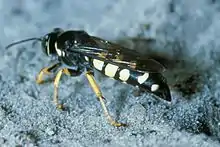Horse guard wasp
The horse guard wasp (Stictia carolina) is a type of sand wasp (Bembicini) from the eastern United States which preys primarily upon horse-flies (Tabanidae). It is a large, colorful, fast-flying wasp, one of 28 species in the genus Stictia (which occur throughout North and South America), all of which have similar biology.[1]
| Horse guard | |
|---|---|
 | |
| Scientific classification | |
| Domain: | Eukaryota |
| Kingdom: | Animalia |
| Phylum: | Arthropoda |
| Class: | Insecta |
| Order: | Hymenoptera |
| Family: | Crabronidae |
| Genus: | Stictia |
| Species: | S. carolina |
| Binomial name | |
| Stictia carolina Fabricius, 1793 | |
Biology
A female wasp of this species may take anywhere from 30 to 60 flies as food to provision each one of her nests; she makes a new nest for every egg she lays. Nests are simple burrows some 15 cm deep, with a single enlarged chamber at the bottom. An egg is laid in the empty chamber, and the female wasp brings back paralyzed flies and sometimes silver-spotted skipper larvae until the chamber is full (mass provisioning), at which point she closes the nest and begins another.[2] Numerous females often excavate nests within a small area where the soil is suitable, creating large and sometimes very dense nesting aggregations. Nearly all the prey are biting female horse-flies; exceptionally, other flies such as Odontomyia and the screw-worm fly Cochliomyia are taken.[3]
Horses and cattle are not disturbed by the presence of the horse guard wasp, despite its rapid flight and loud buzzing; the same animals may however respond strongly to horse-flies or bot flies.[1] Nonetheless, these beneficial wasps are sometimes eliminated by horse owners unfamiliar with them, thus exacerbating their problems with horse-flies.
The horse guard wasp acts as a natural biological control, helping to keep horse fly populations down. This makes it important to the economies of those areas where horses are reared; in the words of Bohart and Menke, it "fully lives up to its name".[1]
The generic name "Stictia" may be related to Ancient Greek "stictis" which means "spotted"; the specific name "carolina" is a reference to the eastern American state to which this species is native. It occurs from the 100th meridian eastwards, and as far north as Pennsylvania.[1]
References
- Bohart, Richard Mitchell; Menke, Arnold S. (1 January 1976). Sphecid Wasps of the World: A Generic Revision. University of California Press. pp. 541–542. ISBN 978-0-520-02318-5.
- Hall, Donald W. (2017). "Silver-Spotted Skipper Epargyreus clarus (Cramer)". The Institute of Food and Agricultural Sciences Extension.
- Martin, Anthony J. (2013). Life Traces of the Georgia Coast: Revealing the Unseen Lives of Plants and Animals. Indiana University Press. pp. 209–210. ISBN 978-0-253-00602-8.